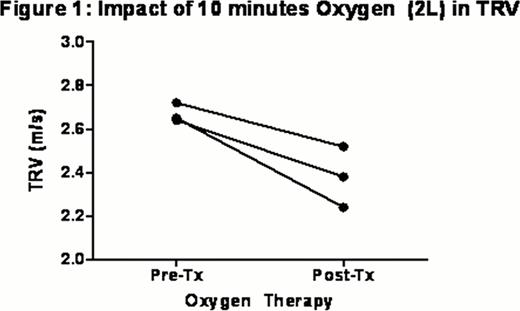Abstract
Abstract 4752
An elevated TRV on Doppler echocardiography (echo) identifies pulmonary hypertension (PH) risk, is common in SCD, and is associated with mortality in adults. An elevated TRV is found in 11–15% of children with SCD, and is associated with decreased exercise capacity and low oxygen saturations. An acute rise in pulmonary presssures can compromise oxygenation and contribute to risk of erythrocyte sickling. Acute TRV elevation in SCD has been recently described in adults with VOE and acute chest syndrome (ACS) however studies in children have not previously been performed. The impact of oxygen administration on TRV during VOE is unknown.
To investigate TRV in children with SCD and VOE together with biomarkers of hemolysis, and the impact of oxygen administration.
Investigational intervention without random assignment; Prospective Descriptive Study. Children 1–21 years with a diagnosis of SCD requiring parenteral narcotics for VOE were enrolled within 24 hours of presentation to an urban emergency department (ED). Estimated pulmonary pressures were noninvasively measured by transthoracic echo. A TRV≥2.5 m/s was used to define PH risk. All measurements were made by a single trained sonographer at bedside. Patients with a TRV>2.5 m/s were administered oxygen by nasal cannula at 2 LPM for 10 minutes, followed by repeated TRV measurement. Secondary outcome measures included correlation of biomarkers of hemolysis and QTc interval with TRV, as well as the effect of oxygen administration on TRV.
22 events were studied in 19 unique subjects, 3 of whom were enrolled twice. Mean age was 16±5 years (range: 4–21 years), 64% were female, and 64% had Hb SS, 27% Hb SC and 9% Hb SbThal. Pain scores were 6±3, mean Hb was 9.6±1.8 g/dL, 9% of children had a borderline/prolonged QTc, and all but 1 patient was admitted for VOE. Mean length of admission was 5±3 days. Chest radiography done on 5/15 (33.3%) revealed an infiltrate, while 3/5 (60%) patients presenting with fever and VOE ultimately developed ACS. 6/22 (27%) episodes required transfusion. Measurements of TRV during VOE were recorded in all 22 patients (mean: 2.11±0.46 m/s; range: 0.98–2.72 m/s). 3 subjects (2 unique subjects, 10%) had a TRV≥2.5 m/s during VOE suggesting PH-risk. Oxygen was administered to patients meeting criteria of PH-risk and all had a reduction in TRV of 0.26, 0.41 and 0.2 m/s respectively (Figure 1). Echos were reviewed by a blinded cardiologist with a concordance correlation coefficient of 0.9431 between evaluators, reflecting good inter-rater reliability. Correlation of secondary outcome measures revealed a statistically significant relationship between reticulocyte count and TRV (ρ=0.5, p=0.02) only. No associations between TRV and Hb, WBC, cell-free Hb, LDH, arginase concentration, pain scores, ACS or QTc were observed. As previously reported, arginase concentration correlated strongly to cell-free Hb (r=0.60, p=0.04).
Our preliminary data suggests that an elevated TRV may be less common in children compared to adults with SCD and VOE based on previous published reports. A 10% prevalence of TRV elevation identified in this study is similar to the reported baseline prevalence in children. The role of oxygen administration during VOE and its impact on TRV requires further study. A reduction of TRV in our small cohort however may prove to be clinically relevant, particularly in the acute ED setting. 9% of children presented with a borderline/prolonged QTc, which may have implications when utilizing medications which prolong QTc. Further data is required before conclusions may be drawn regarding TRV elevation in children with SCD and VOE and enrollment is ongoing.
No relevant conflicts of interest to declare.
Author notes
Asterisk with author names denotes non-ASH members.


This feature is available to Subscribers Only
Sign In or Create an Account Close Modal